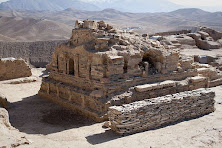 |
| Mes Aynak (Wikipedia commons) |
"With the Taliban takeover of Afghanistan, the country's archaeological remains face a grim future even if the extremist Islamic group decides not to loot or intentionally destroy them" reports Owen Jarus ('The Taliban may be hunting for Afghanistan's most famous treasure', Live Science 23 Sept 2021). " So far there have been no reports of the Taliban intentionally destroying artifacts, and the Taliban leadership has issued statements saying that they will protect archaeological sites; however, whether the Taliban will actually follow through on their promises is unknown".
"The situation for culture heritage is not OK, because right now no one is taking care of the sites and monuments," said Khair Muhammad Khairzada, an archaeologist who led excavations at Mes Aynak, a Buddhist city (on what Eurocentrists call 'the Silk Road') that flourished around 1,600 years ago where there are numerous ancient Buddhist monasteries and other ancient Buddhist artifacts.
But over in America, an eye is being kept on things:
"All archaeological sites in Afghanistan are [at] risk," said Khairzada, noting that there is "no monitoring, no treatment and no care, all departments in all province [are] closed, without money and other facilities" that are needed to "take care [of] the sites and monuments." Recently, Khairzada was forced to flee to France to escape the Taliban. Khairzada said that all the equipment that they had used for excavation and conservation at Mes Aynak is "gone." China holds mining rights in the nearby areas and even before the Taliban took over archaeologists feared that parts of the site could be destroyed if it were turned into a mine. After the Taliban took over Kabul they announced that they would seek economic support from China, but it is unclear if China intends to build a mine in the area. Julio Bendezu-Sarmiento, who was director of the French Archaeological Delegation to Afghanistan, said that he has learned that the Taliban have visited Mes Aynak but is uncertain why. "It is difficult to say what the immediate objectives of this visit are," Bendezu-Sarmiento said. There had been plans to hold an exhibition of artifacts from Mes Aynak and other Afghanistan sites in France in 2022, but the Taliban captured Kabul before artifacts could be transported.And of course, if mining begins without the documentation being finished, and somebody involves decides to remove sculptures and place them on the market, dealers and collectors will claim they are "saving" them from destruction by providing that market. [Mr Jarus might note that Mes Ayak abnd Bamiyan are not teh same site, they are 150 km apart].
But over in America, an eye is being kept on things:
Along with his team, Gil Stein, a professor at the University of Chicago's Oriental Institute who leads the Afghan Heritage Mapping Partnership, has been using satellite imagery to map and monitor thousands of archaeological sites in Afghanistan. Stein estimates that they have mapped out the location of about 25,000 archaeological sites in Afghanistan so far. Looting is a long-running problem in Afghanistan, but Stein said that so far he has found no evidence that the Taliban have been supporting it. While the Taliban took control of Kabul and parts of northern Afghanistan recently, they have been in control of parts of southern Afghanistan for several years. Areas in the south that the Taliban have controlled for years don't have the large-scale looting that was seen in territories controlled by the Islamic State group (ISIS or ISIL) in Syria and Iraq, Stein told Live Science. "Basically, the Taliban were not sponsoring looting as a source of income the way [ISIL] was doing," Stein said. However, the team has found many cases in southern Afghanistan where agricultural fields, which often grow opium, were built over archaeological sites. The Taliban "didn't need to sponsor looting because they have been making such an enormous amount of money from the opium trade," Stein said. The northern areas of Afghanistan, which the Taliban has only recently taken over, hold far more archaeological sites than the southern areas. After examining recent satellite imagery of northern Afghanistan, Stein's team saw "battle-related damage" but not new cases of wide-scale looting.Hmmm. Dr Stein is following along with the US mantra-for-the-masses, as Sam Hardy and others (including this blog) have shown, this simplistic model is wrong. It seems that as UK metal detectorists claiming they are "not-like-the-nighthawks" is legitimation of what they do, here "not-like-ISIL" has the same function.





.jpg)

No comments:
Post a Comment